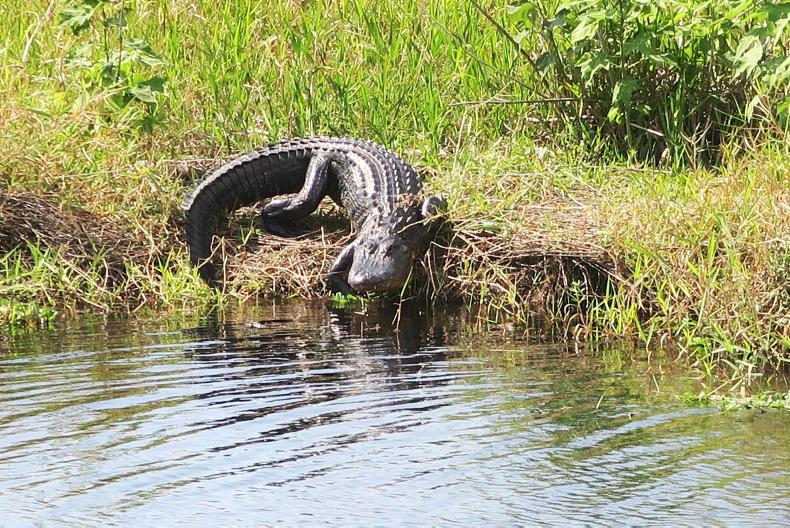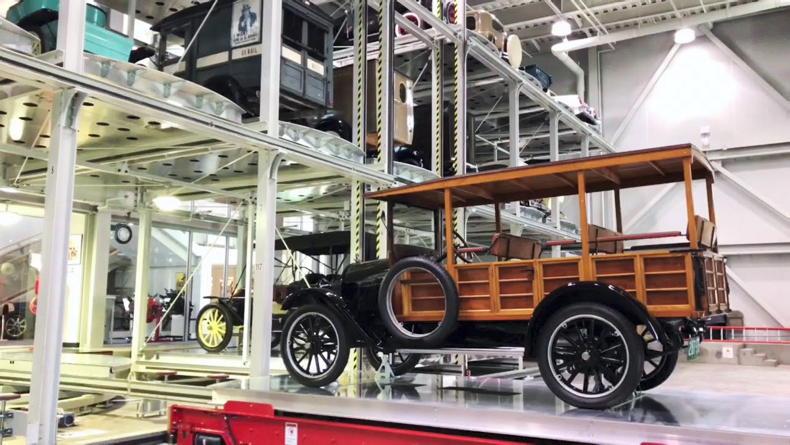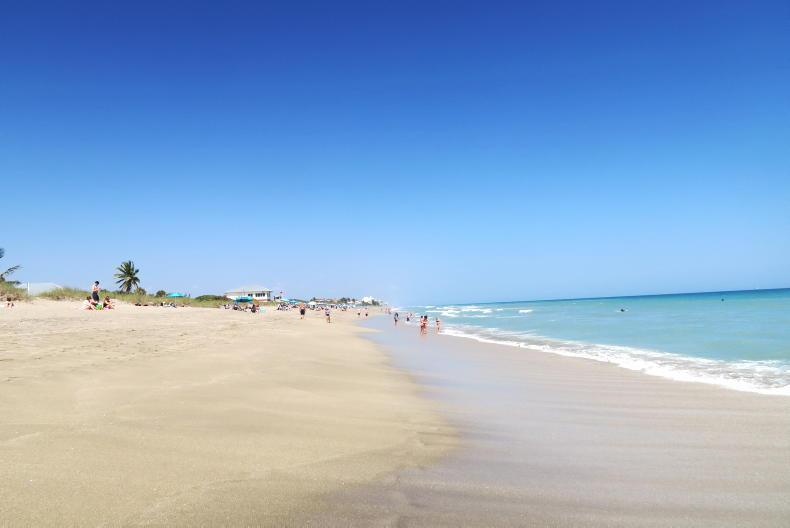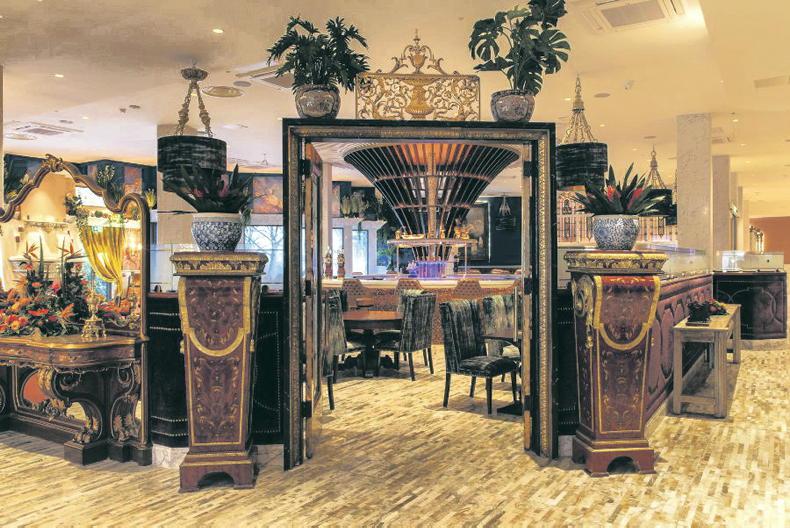The first time I saw an alligator in the wild, it put the heart crossways in me.
I was in the DuPuis Wildlife Management Area, a 22,000ac protected area which forms a single link in a vast greenway system that sprawls across southern Florida. The Florida Fish and Wildlife Conservation Commission oversees more than six million acres of land established as wildlife management areas, popular with the locals for fishing, hiking and hunting in every form. For the most part there are no admission charges, no signs with stern lists of dos and don’ts, no little maps with colour coded walking trails. You can go where you like, do what you like; and if you disappear and your partially eaten corpse later turns up bobbing in a swamp, that is no one’s lookout but your own.
I visited DuPuis with Limerick native and adoptive Floridian Noel Ryan, despite bitter experience indicating that the most innocent seeming excursions with Noel generally take an unexpected and potentially lethal turn. We were standing on a causeway between two deep drainage channels, soaking up the blazing sun and admiring a flock of egrets feeding at the water’s edge, when Noel drew my attention to a huge knobbled wicked-looking gator who appeared out of the weeds behind us, slunk across the causeway with a flat-footed, indefinably menacing gait, then slipped down into the still water at the other side. The whole operation had been accomplished in complete silence, apart from my falsetto shrieks of alarm, and it was only by the grace of God that our friend hadn’t chosen to cross exactly where we were standing and help himself to a snack en route. There is an invigorating in-the-moment quality to visiting a beauty spot where there is a real chance of being eaten that you simply don’t get in Phoenix Park.
Seminole Inn
Hungry for a faint taste of civilization, we drove to nearby Indiantown, a dusty settlement in the heart of citrus and cattle country, and got a flavour of the Florida that existed before Disneyland and Miami Beach. When we pushed through the grand French doors into the dim cool of the Seminole Inn, the most notable building in town, there were neither staff nor customers to be seen and Frank Sinatra was crooning on the radio. I half expected to see the man himself nursing a glass of bourbon at the bar with his fedora hat cocked over one eye; it was that sort of place. The Seminole Inn, which features on the National Register of Historic Places, was built during the Florida land boom of the 1920s by Solomon Davies Warfield, an optimistic railroad executive who believed that Indiantown was on the cusp of great things. The most famous guest of the hotel was Mr Warfield’s niece, Wallis Warfield Simpson, who later won notoriety as the Duchess of Windsor and the wife of the former King Edward VIII.

Alligator in DuPuis Wildlife Management Area. \ Liam Clancy
Despite being as far south as you can get in the United States, the lower half of the Florida Peninsula does not have the distinctive southern culture you find in Alabama or Georgia. A third of southern Florida’s population was born in a different state; another third originated outside of the US. When I turned the key in my hire car at West Palm Beach airport, the first thing that struck me was the Hispanic music belting out of the radio.
Billionaire Island
The lively and attractive city of West Palm Beach is rich in palm trees but notably lacking in beaches. For these one must cross the Lake Worth Lagoon to the separate town of Palm Beach, located on one of the narrow barrier islands that line Florida’s east coast. Palm Beach Island is little over 10 square miles in area, but is home to over 30 billionaires, including, most famously, Donald Trump. There is not a single home or shop on the island that is not pristine or jaw-droppingly fabulous.
About 45 miles to the north is the pretty town of Stuart, built on the St Lucie River estuary and frequently cited as one of the best small towns to visit in the US. Stuart was full of happy retirees just waiting to catch my eye so they could stop me for long conversations about golf or fishing. I enjoyed an excellent seafood lunch with friends at the Twisted Tuna in Port Salerno, a historic fishing village on an inlet of the St Lucie estuary known as the Manatee Pocket.

The Elliott Museum on Hutchinson Island. \ Liam Clancy
Elliott Museum
Stuart has its own barrier island shielding it from the Atlantic rollers; Hutchinson Island, 23 miles long and not much more than a few hundred yards wide. Hutchinson Island has miles of stunning golden beaches, and in the summer months is one of the most important nesting areas for loggerhead turtles in the world. For the visitor who is lukewarm about turtles but likes cars, a visit to the Elliott Museum and its comprehensive collection of vintage vehicles is a must. The museum has a feature that no other museum in the world can boast: one entire side of the building is taken up by a three-storey automated conveyor system that houses more than 50 vehicles. You can order any car that interests you on a computer, and within minutes it is delivered to a turntable where it slowly spins for your detailed scrutiny.
The stretch of coastline north and south of Stuart is romantically known as The Treasure Coast. In 1715 a homeward-bound Spanish fleet, loaded with gold and silver from the New World, was caught in a hurricane here and all 11 ships were lost. To this day coins and artifacts from the wrecks regularly wash up on the Florida beaches, and an estimated $400m in coins still lie undiscovered on the seabed.
The Treasure Coast region of Florida is an exciting, vivid place, with its tropical climate, its dazzling bird-life, its destructive hurricanes and mysterious swamps full of things that want to kill you. Diving for lost Spanish gold may be a touch too adventurous for you, but the region offers many other hidden treasures waiting to be uncovered by the inquisitive visitor.
United Airlines runs daily flights from Dublin to West Palm Beach (change in Newark). Prices from €521 per traveller. Best centres for exploring Florida’s Treasure Coast are West Palm Beach, Stuart and Fort Lauderdale.
Read more
A family escape to the Amalfi Coast
Travel: la vita e bella! When in Rome
The first time I saw an alligator in the wild, it put the heart crossways in me.
I was in the DuPuis Wildlife Management Area, a 22,000ac protected area which forms a single link in a vast greenway system that sprawls across southern Florida. The Florida Fish and Wildlife Conservation Commission oversees more than six million acres of land established as wildlife management areas, popular with the locals for fishing, hiking and hunting in every form. For the most part there are no admission charges, no signs with stern lists of dos and don’ts, no little maps with colour coded walking trails. You can go where you like, do what you like; and if you disappear and your partially eaten corpse later turns up bobbing in a swamp, that is no one’s lookout but your own.
I visited DuPuis with Limerick native and adoptive Floridian Noel Ryan, despite bitter experience indicating that the most innocent seeming excursions with Noel generally take an unexpected and potentially lethal turn. We were standing on a causeway between two deep drainage channels, soaking up the blazing sun and admiring a flock of egrets feeding at the water’s edge, when Noel drew my attention to a huge knobbled wicked-looking gator who appeared out of the weeds behind us, slunk across the causeway with a flat-footed, indefinably menacing gait, then slipped down into the still water at the other side. The whole operation had been accomplished in complete silence, apart from my falsetto shrieks of alarm, and it was only by the grace of God that our friend hadn’t chosen to cross exactly where we were standing and help himself to a snack en route. There is an invigorating in-the-moment quality to visiting a beauty spot where there is a real chance of being eaten that you simply don’t get in Phoenix Park.
Seminole Inn
Hungry for a faint taste of civilization, we drove to nearby Indiantown, a dusty settlement in the heart of citrus and cattle country, and got a flavour of the Florida that existed before Disneyland and Miami Beach. When we pushed through the grand French doors into the dim cool of the Seminole Inn, the most notable building in town, there were neither staff nor customers to be seen and Frank Sinatra was crooning on the radio. I half expected to see the man himself nursing a glass of bourbon at the bar with his fedora hat cocked over one eye; it was that sort of place. The Seminole Inn, which features on the National Register of Historic Places, was built during the Florida land boom of the 1920s by Solomon Davies Warfield, an optimistic railroad executive who believed that Indiantown was on the cusp of great things. The most famous guest of the hotel was Mr Warfield’s niece, Wallis Warfield Simpson, who later won notoriety as the Duchess of Windsor and the wife of the former King Edward VIII.

Alligator in DuPuis Wildlife Management Area. \ Liam Clancy
Despite being as far south as you can get in the United States, the lower half of the Florida Peninsula does not have the distinctive southern culture you find in Alabama or Georgia. A third of southern Florida’s population was born in a different state; another third originated outside of the US. When I turned the key in my hire car at West Palm Beach airport, the first thing that struck me was the Hispanic music belting out of the radio.
Billionaire Island
The lively and attractive city of West Palm Beach is rich in palm trees but notably lacking in beaches. For these one must cross the Lake Worth Lagoon to the separate town of Palm Beach, located on one of the narrow barrier islands that line Florida’s east coast. Palm Beach Island is little over 10 square miles in area, but is home to over 30 billionaires, including, most famously, Donald Trump. There is not a single home or shop on the island that is not pristine or jaw-droppingly fabulous.
About 45 miles to the north is the pretty town of Stuart, built on the St Lucie River estuary and frequently cited as one of the best small towns to visit in the US. Stuart was full of happy retirees just waiting to catch my eye so they could stop me for long conversations about golf or fishing. I enjoyed an excellent seafood lunch with friends at the Twisted Tuna in Port Salerno, a historic fishing village on an inlet of the St Lucie estuary known as the Manatee Pocket.

The Elliott Museum on Hutchinson Island. \ Liam Clancy
Elliott Museum
Stuart has its own barrier island shielding it from the Atlantic rollers; Hutchinson Island, 23 miles long and not much more than a few hundred yards wide. Hutchinson Island has miles of stunning golden beaches, and in the summer months is one of the most important nesting areas for loggerhead turtles in the world. For the visitor who is lukewarm about turtles but likes cars, a visit to the Elliott Museum and its comprehensive collection of vintage vehicles is a must. The museum has a feature that no other museum in the world can boast: one entire side of the building is taken up by a three-storey automated conveyor system that houses more than 50 vehicles. You can order any car that interests you on a computer, and within minutes it is delivered to a turntable where it slowly spins for your detailed scrutiny.
The stretch of coastline north and south of Stuart is romantically known as The Treasure Coast. In 1715 a homeward-bound Spanish fleet, loaded with gold and silver from the New World, was caught in a hurricane here and all 11 ships were lost. To this day coins and artifacts from the wrecks regularly wash up on the Florida beaches, and an estimated $400m in coins still lie undiscovered on the seabed.
The Treasure Coast region of Florida is an exciting, vivid place, with its tropical climate, its dazzling bird-life, its destructive hurricanes and mysterious swamps full of things that want to kill you. Diving for lost Spanish gold may be a touch too adventurous for you, but the region offers many other hidden treasures waiting to be uncovered by the inquisitive visitor.
United Airlines runs daily flights from Dublin to West Palm Beach (change in Newark). Prices from €521 per traveller. Best centres for exploring Florida’s Treasure Coast are West Palm Beach, Stuart and Fort Lauderdale.
Read more
A family escape to the Amalfi Coast
Travel: la vita e bella! When in Rome












SHARING OPTIONS